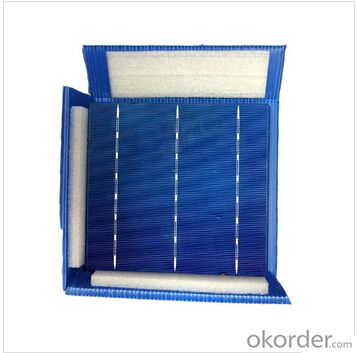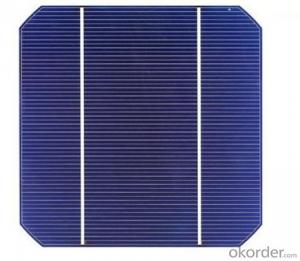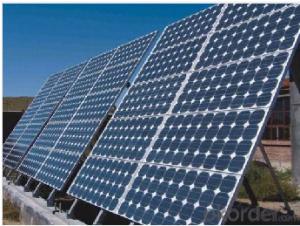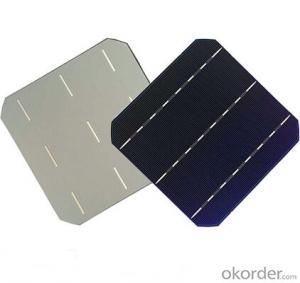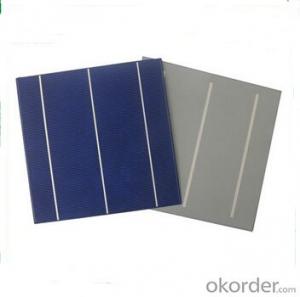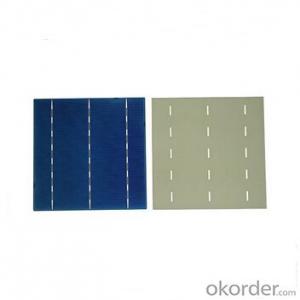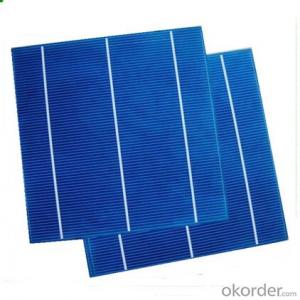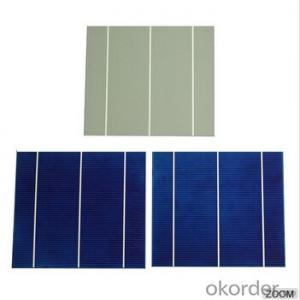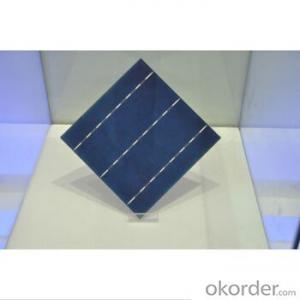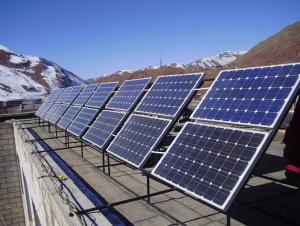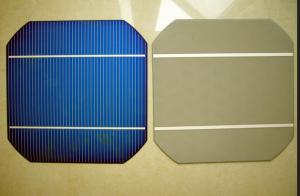High Quality 16.25%-16.50% Effy Polycrystalline Solar Cells for Home
- Loading Port:
- Shanghai
- Payment Terms:
- TT OR LC
- Min Order Qty:
- 1000 pc
- Supply Capability:
- 1000000 pc/month
OKorder Service Pledge
OKorder Financial Service
You Might Also Like
Solar Cells:
solar cells, when struck by photons of light from the sun, generates an electrical current which can then be used to power DC or AC electrical loads.
A solar cell is made of silicon. Computer chips are made of this same material. Basically, when light strikes the surface of a solar cell some of it is absorbed into the silicon. This light energy bumps the electrons loose and causes energy to flow
Solar cells is made by solar wafer, it has three categories of solar cell right now, monocrystalline polycrystalline and thin film,These cells are entirely based around the concept of PN junction, which is the critical part of solar module, it is the part that can convert the light energy into electricity, the thickness is from 180um to 200um, with even busbars to conduct electricity, textured cell can decrease diffuse reflection; they are often electrically connected and encapsulated as a module. Photovoltaic modules often have a sheet of glass on the front (sun up) side, allowing light to pass while protecting semiconductor wafers from abrasion and impact due to wind-driven debris, rain, hail, etc. Solar cells are also usually connected in series in modules, creating an additive voltage. Connecting cells in parallel will yield a higher current;With high quality and stable quality. Our Cells can greatly improve the performance of Solar Modules.
Features:
High efficiencies up to 16.4%
Proven long term mechanical stability of silicone
Make of highly purified poly silicone
Three bus bars for reduced series resistance and improved module and cell efficiency
Blue anti-reflecting coating ensures improved light absorption and increased efficiency
Acid texturization offers a uniform appearance and virtually invisible crystal structure
Excellent low light behavior for improved energy yield
Specifications
Size | 156mm x156mm ±0.5mm | |||||
Thickness | 190um ± 20um | |||||
Front surface(-) | 1.7mm bus bars(silver), blue anti-reflecting coating(Silicon nitride) | |||||
Back surface (+) | 3mm wide soldering pads(silver) back surface field(Aluminum) | |||||
TkVoltage | -0.351%/K | |||||
TkCurrent | +0.035%/K | |||||
TkPower | -0.47%/K | |||||
Efficiency(%) | Pmp(W) | Vmp(V) | Imp(A) | Voc(V) | Isc(A) | FF(%) |
16.25-16.50 | 3.99 | 0.516 | 7.731 | 0.621 | 8.262 | 77.77 |
16.00-16.25 | 3.92 | 0.512 | 7.660 | 0.616 | 8.195 | 77.68 |
15.75-16.00 | 3.86 | 0.509 | 7.584 | 0.613 | 8.135 | 77.43 |
15.50-15.75 | 3.80 | 0.505 | 7.525 | 0.611 | 8.080 | 77.04 |
15.25-15.50 | 3.74 | 0.502 | 7.458 | 0.609 | 8.053 | 76.20 |
Solar Cells Advantage:
• High efficiency and stable performance in photovoltaic conversion.
• Advanced diffusion technique ensuring the homogeneity of energy conversion efficiency of the cell.
• Advanced PECVD film forming, providing a dark blue silicon nitride anti-reflection film of homogenous color and attractive appearance.
• High quality metal paste for back surface and electrode, ensuring good conductivity, high pulling strength and ease of soldering.
• High precision patterning using screen printing, ensuring accurate busbar location for ease with automatic soldering a laser cutting.
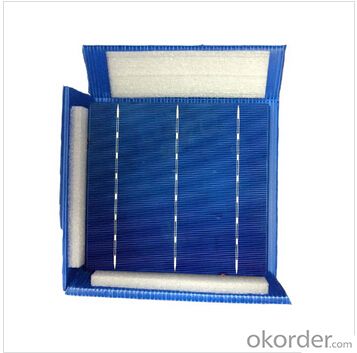
FAQ
We have organized several common questions for our clients,may help you sincerely:
①What price for each watt?
It depends on the efficiency of the solar cell, quantity, delivery date and payment terms.
②How long can we receive the product after purchase?
In the purchase of product within three working days, We will arrange the factory delivery as soon as possible. The pecific time of receiving is related to the state and position of customers.Commonly 7 to 10 working days can be served.
③Can you provide the peripheral products of the solar panels, such as the battery, controller, and inverter? If so, can you tell me how do they match each other?
Yes, we can, we have two companies for solar region, one is CNBM International, the other is CNBM engineering Co.
We can provide you not only the solar module but also the off grid solar system, we can also provide you service with on grid plant.
④What is your warranty of solar cell?
Our product can promise lower than 0.3% open box crack, we support claim after opening the box if it has crackm color difference or sth, the buyer should give pictures immediately, we can not accept the claim after the solar cell has assembled to solar panel.
• Timeliness of delivery
• ⑤How do you pack your products?
We have rich experience on how to pack the solar cell to make sure the safety on shipment, we could use wooden box or pallet as buyer's preference.
- Q: What is the maximum efficiency achievable by a solar cell?
- The maximum efficiency achievable by a solar cell is determined by the Shockley-Queisser limit, which states that the theoretical maximum efficiency is around 33.7% for a single-junction solar cell. However, in reality, due to factors such as material limitations and losses in the conversion process, the practical maximum efficiency of commercial solar cells currently ranges between 15% to 22%.
- Q: Can solar cells be used to power satellites?
- Yes, solar cells can be used to power satellites. In fact, they are the primary source of power for most satellites in space. Solar cells convert sunlight into electricity, which is then used to power the various systems and instruments on board the satellite.
- Q: I know that solar cells are produced by DC and then converted into alternating current through the inverter, who explains why the solar cell is produced by DC?
- The electrons in the outer layer of the semiconductor nuclei are absorbed into the high energy level when they are exposed to light. The unstable electrons are returned to the semiconductor by the external circuit. The direction of the movement of the electrons in the external circuit is determined.
- Q: How do solar cells perform in high altitude locations?
- Solar cells generally perform better in high altitude locations compared to lower altitude areas. This is because higher altitudes often have less atmospheric interference, such as pollution and cloud cover, which can obstruct sunlight. Additionally, the thinner atmosphere at high altitudes allows for more direct and intense sunlight, resulting in increased solar energy generation. Overall, solar cells in high altitude locations can harness more sunlight and produce higher energy output.
- Q: What is the impact of dust and dirt on solar cell performance?
- Dust and dirt on solar cell surfaces can significantly impact their performance. They can reduce the amount of sunlight reaching the cells, leading to decreased energy production. The accumulation of dust particles can create a barrier, preventing photons from penetrating the solar cells effectively. This reduces the conversion efficiency and overall power output of the solar panels. Regular cleaning and maintenance are crucial to ensure optimal performance and maximize the energy generation potential of solar cells.
- Q: Can solar cells be used in water pumps?
- Yes, solar cells can be used in water pumps. Solar-powered water pumps are designed to convert sunlight into electricity, which can be used to power the pump and move water. This technology is particularly useful in areas with limited access to electricity or where grid power is unreliable. Solar-powered water pumps are efficient, environmentally friendly, and provide a sustainable solution for water pumping needs.
- Q: What's the relationship between solar energy materials and solar cells?
- Solar cells are used for the direct conversion in changing the light energy into electrical energy. At present, a large number of terrestrial photovoltaic systems are actually made by silicon solar cells, which can be divided into silicon, polycrystalline silicon, amorphous silicon solar cells.
- Q: Can solar cells be used in residential applications?
- Yes, solar cells can be used in residential applications. They are commonly used to generate electricity for homes by converting sunlight into electrical energy. This renewable energy source can help reduce reliance on traditional electricity grids, lower electricity bills, and contribute to a more sustainable and environmentally friendly lifestyle.
- Q: Can solar cells be used for telecommunications infrastructure?
- Yes, solar cells can be used for telecommunications infrastructure. Solar cells can generate electricity from sunlight, making them an ideal renewable energy source for powering remote telecommunications towers, base stations, and other infrastructure. They can provide a reliable and sustainable power supply in areas where grid electricity is unavailable or unreliable, reducing dependence on fossil fuels and minimizing operational costs.
- Q: How do solar cells perform in humid climates?
- Solar cells can still perform efficiently in humid climates. However, high humidity levels can slightly reduce the overall performance of solar cells due to the moisture in the air. The moisture can create a thin film on the surface of the solar panels, which reduces the amount of sunlight that can be absorbed by the cells. Additionally, increased humidity can also affect the electrical connections and can potentially lead to corrosion or damage over time. Nonetheless, advancements in solar cell technology, such as anti-reflective coatings and improved waterproofing, have helped mitigate the impact of humidity on solar cell performance.
Send your message to us
High Quality 16.25%-16.50% Effy Polycrystalline Solar Cells for Home
- Loading Port:
- Shanghai
- Payment Terms:
- TT OR LC
- Min Order Qty:
- 1000 pc
- Supply Capability:
- 1000000 pc/month
OKorder Service Pledge
OKorder Financial Service
Similar products
Hot products
Hot Searches
Related keywords



